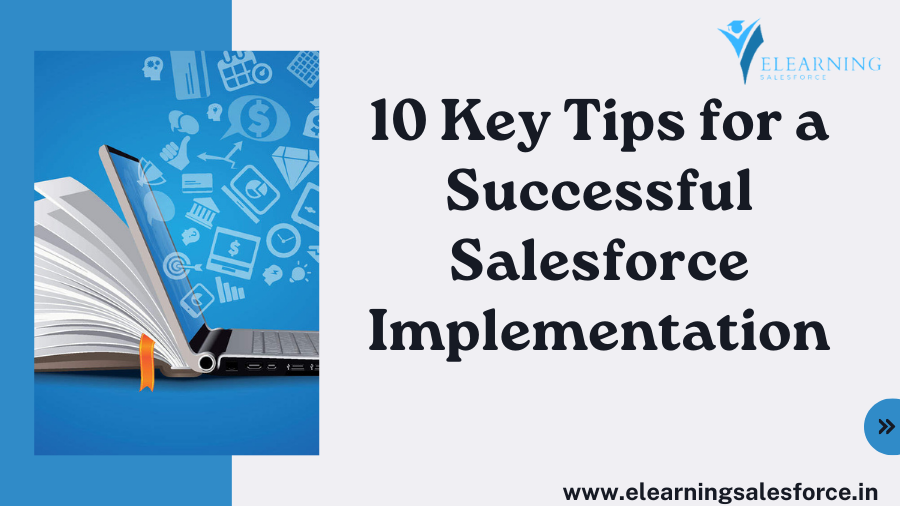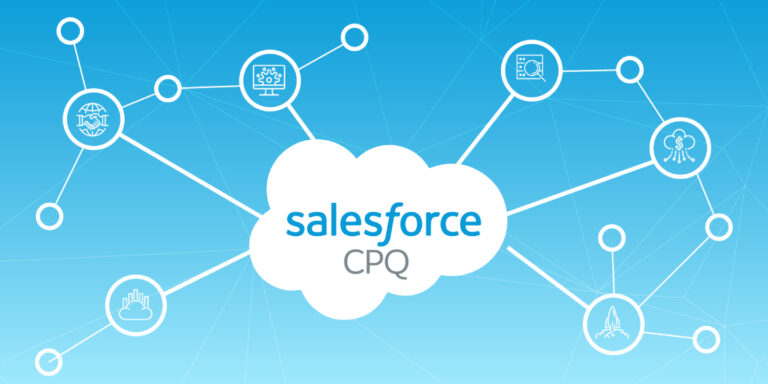Introduction: Salesforce is a powerful and versatile Customer Relationship Management (CRM) platform that has revolutionized the way businesses manage customer interactions and drive growth. However, implementing Salesforce effectively requires careful planning, preparation, and execution. In this blog, we will explore ten essential tips to ensure a successful Salesforce implementation, empowering your organization to unlock the full potential of this leading CRM platform. Salesforce Configuration
What is the Salesforce implementation?
Salesforce implementation refers to the process of setting up and configuring the Salesforce platform to meet the specific needs and requirements of an organization. It involves the deployment and customization of Salesforce’s various products, such as Sales Cloud, Service Cloud, Marketing Cloud, and more, to streamline business processes, enhance customer relationships, and drive business growth.
The Salesforce Configuration process typically involves the following key steps:
- Requirements Gathering: In the initial phase, stakeholders from different departments collaborate to define the organization’s business requirements and objectives for Salesforce. This involves understanding current processes, pain points, and desired outcomes.
- Planning: Once the requirements are identified, a detailed implementation plan is created. The plan outlines the scope of the project, the timeline, resource allocation, and the specific Salesforce products and features to be implemented.
- Data Migration and Cleanup: Before deploying Salesforce, existing data from various sources must be migrated into the platform. This involves data mapping, data transformation, and data cleansing to ensure data accuracy and consistency.
- Configuration and Customization: Salesforce is a highly customizable platform. During this phase, the implementation team configures Salesforce to match the organization’s specific workflows and processes. Customizations may involve creating custom objects, fields, page layouts, and validation rules.
- User Training: Proper user training is crucial to ensure successful adoption of Salesforce. The implementation team conducts training sessions to familiarize employees with the platform’s features and functionalities and teach them how to perform their tasks effectively.
- Testing and Quality Assurance: Extensive testing is conducted to ensure that the Salesforce implementation functions as expected and meets the defined requirements. Testing includes unit testing, integration testing, and user acceptance testing (UAT).
- Go-Live and Post-Implementation Support: Once all testing is successfully completed, the organization goes live with Salesforce. Post-implementation support is provided to address any issues or questions that may arise during the initial usage of the platform.
- Ongoing Monitoring and Optimization: After the implementation, organizations continuously monitor and evaluate Salesforce’s performance and impact on business processes. Feedback from users is collected, and adjustments are made as needed to optimize the system’s effectiveness.
Salesforce implementation is a collaborative effort that involves a dedicated implementation team, which may include project managers, Salesforce administrators, developers, and subject matter experts from various departments. A successful implementation ensures that Salesforce becomes a powerful tool that empowers the organization to manage customer relationships efficiently, streamline processes, and make data-driven decisions for sustainable growth and success.
10 Key Tips for a Successful Salesforce Implementation
- Define Clear Objectives and Requirements
The first step in any successful Salesforce implementation is to define clear objectives and requirements. Work closely with stakeholders from different departments to understand their needs and pain points. Establish measurable goals that align with your organization’s overall business strategy. Defining these objectives will serve as a roadmap throughout the implementation process, guiding decision-making and prioritization. Salesforce Configuration
- Assemble a Dedicated Implementation Team
Building a dedicated implementation team is crucial to the success of your Salesforce project. The team should include a mix of skilled professionals, including project managers, Salesforce administrators, developers, and subject matter experts from various departments. This cross-functional team will ensure that all aspects of the implementation are addressed effectively, from technical setup to process optimization. Salesforce Configuration
- Plan Data Migration and Cleanup
Data migration is a critical aspect of any Salesforce implementation. Carefully assess your existing data and plan for its migration into Salesforce. Data cleanup and deduplication are essential to ensure data accuracy and consistency. Invest time in data mapping and transformation to ensure a seamless transfer of information to the new system.
- Invest in User Training and Adoption
User adoption is key to the success of your Salesforce implementation. Prioritize comprehensive user training sessions to ensure that all users are comfortable navigating the new platform and understand its benefits. Consider organizing role-based training to cater to the specific needs of different user groups. Engage employees early in the process to gather feedback and address concerns.
- Choose the Right Salesforce Edition and Features
Salesforce offers various editions and add-on features to cater to different business needs. Choose the edition and features that align with your organization’s requirements and budget. Evaluate whether your organization will benefit from additional features like Sales Cloud, Service Cloud, Marketing Cloud, or custom applications built on the Salesforce platform.
- Design Customization with Long-Term Scalability in Mind
Customization is essential to tailor Salesforce to your organization’s unique processes and workflows. However, it’s essential to design customizations with long-term scalability and flexibility in mind. Avoid overcomplicating the system with unnecessary customizations, as they may become difficult to maintain in the future. Strike a balance between customization and standardization to ensure smooth upgrades and system updates.
- Follow Best Practices for Security and Compliance
Protecting sensitive customer data is paramount. Adhere to best practices for security and compliance when setting up user access controls, data sharing rules, and security settings. Regularly monitor and review user permissions to ensure that data is accessible only to those who need it for their roles.
- Conduct Thorough Testing and Quality Assurance
Thorough testing and quality assurance are vital before deploying Salesforce to your entire organization. Create test scripts that cover all functional areas and conduct various testing cycles, including unit testing, integration testing, and user acceptance testing. Address any issues and bugs promptly to ensure a smooth and error-free go-live.
- Monitor and Evaluate Post-Implementation
The implementation process doesn’t end with the go-live. Continuously monitor user feedback, system performance, and key performance indicators (KPIs) to evaluate the impact of Salesforce on your organization’s processes. Analyze user adoption rates and identify areas where additional training or support may be required. Regularly assess whether your Salesforce implementation aligns with the initial objectives and make adjustments as needed.
- Engage with Salesforce Support and Community
Salesforce offers robust customer support and an active user community. Engage with Salesforce’s support resources, including online documentation, knowledge base articles, and customer success representatives. Leverage the Salesforce user community to learn from others, seek advice, and stay informed about the latest best practices and updates.
What are the steps in Salesforce implementation?
Salesforce implementation involves several key steps to successfully set up and deploy the Salesforce platform to meet your organization’s specific needs. Here is an overview of the typical steps involved in a Salesforce implementation:
- Planning and Strategy:
- Define your organization’s goals and objectives for implementing Salesforce.
- Identify the specific business processes you want to improve or automate using Salesforce.
- Formulate a clear implementation strategy, including timelines, budget, and resources.
- Requirements Gathering:
- Engage with stakeholders from different departments to gather detailed requirements for the Salesforce implementation.
- Document current processes, pain points, and desired outcomes.
- Design and Configuration:
- Design the Salesforce solution based on the gathered requirements.
- Configure Salesforce settings, data model, and custom fields to align with your organization’s processes.
- Set up automation using workflow rules, process builder, and flows.
- Data Migration and Integration:
- Prepare and clean existing data for migration to Salesforce.
- Use data import tools or APIs to migrate data into Salesforce.
- Integrate Salesforce with other systems, if necessary, to ensure seamless data flow.
- Custom Development (if applicable):
- Develop custom functionalities using Apex (Salesforce’s programming language) and Visualforce (for user interface customization).
- Build Lightning Components or use Lightning App Builder for a modern user experience.
- Testing:
- Perform thorough testing of the Salesforce configuration, customizations, and integrations.
- Conduct user acceptance testing (UAT) with end-users to validate that the solution meets their needs.
- Training:
- Provide training to end-users and administrators on how to effectively use Salesforce.
- Create training materials, conduct workshops, and offer ongoing support.
- Deployment:
- Deploy the configured Salesforce solution from the sandbox environment to the production environment.
- Communicate the go-live date to all stakeholders.
- Adoption and Change Management:
- Implement change management strategies to ensure user adoption and a smooth transition to the new system.
- Provide ongoing support and address user concerns.
- Monitoring and Optimization:
- Monitor the performance and usage of the Salesforce system.
- Continuously optimize and refine the implementation based on user feedback and evolving business needs.
- Certification and Compliance:
- Ensure that the Salesforce implementation meets any industry-specific regulations or compliance requirements.
- Documentation:
- Maintain documentation of the implemented solution, including configurations, customizations, and integrations.
Remember that each Salesforce implementation is unique, and the steps can vary based on the complexity of your organization’s requirements. It’s important to engage with experienced Salesforce professionals or consultants to guide you through the implementation process effectively.
Conclusion
A successful Salesforce implementation requires careful planning, collaboration, and a strong focus on user adoption. By defining clear objectives, assembling a dedicated implementation team, and investing in user training, you can ensure a smooth transition to Salesforce. Tailor the platform to your organization’s unique needs through effective customization, data migration, and thorough testing. Regularly monitor and evaluate the impact of Salesforce post-implementation to continually improve processes and optimize performance. Engage with Salesforce’s robust support resources and user community to stay informed and derive maximum value from this powerful CRM platform. With these ten tips in mind, your organization can embark on a successful Salesforce implementation journey, enhancing customer relationships and driving business growth.




